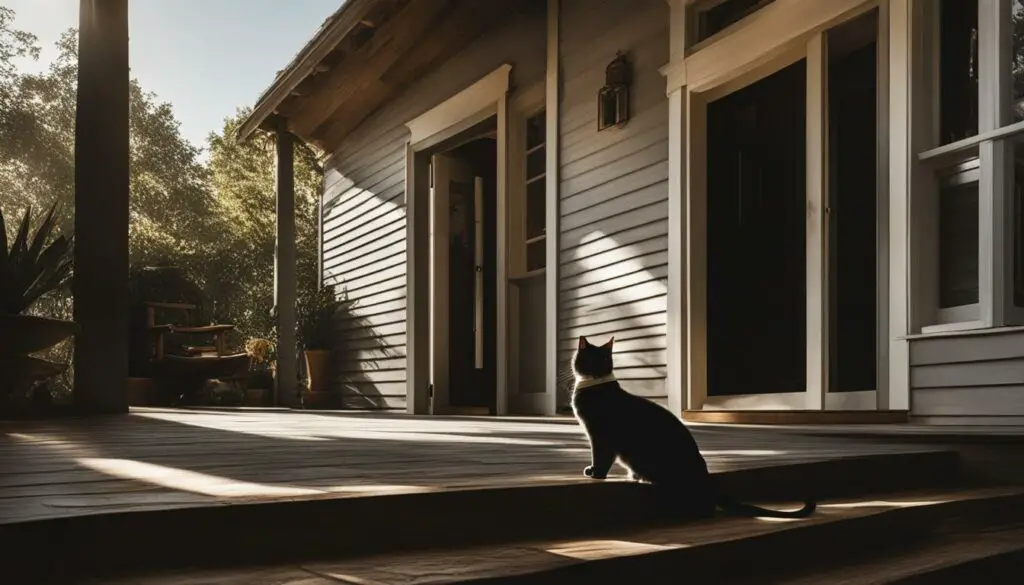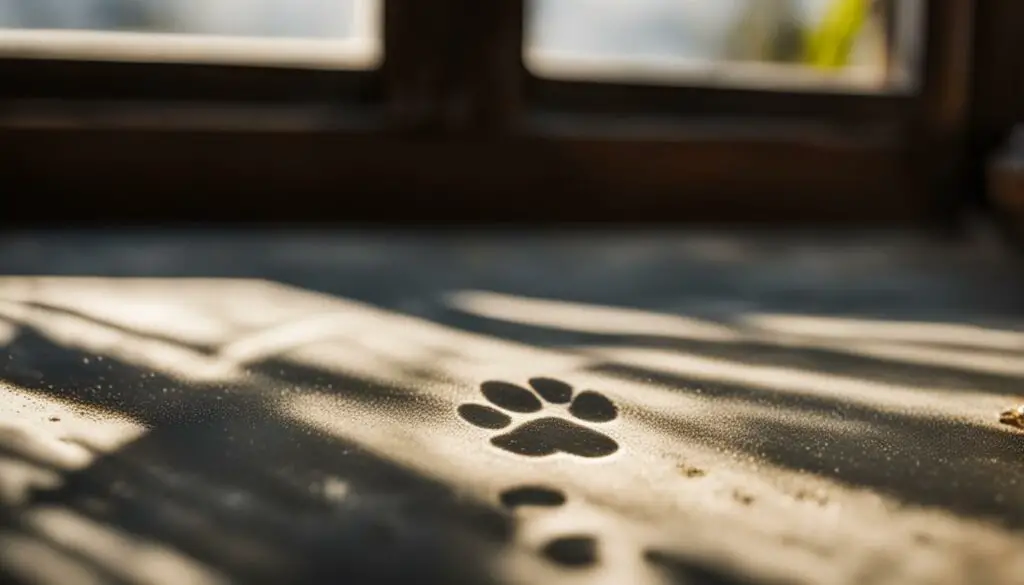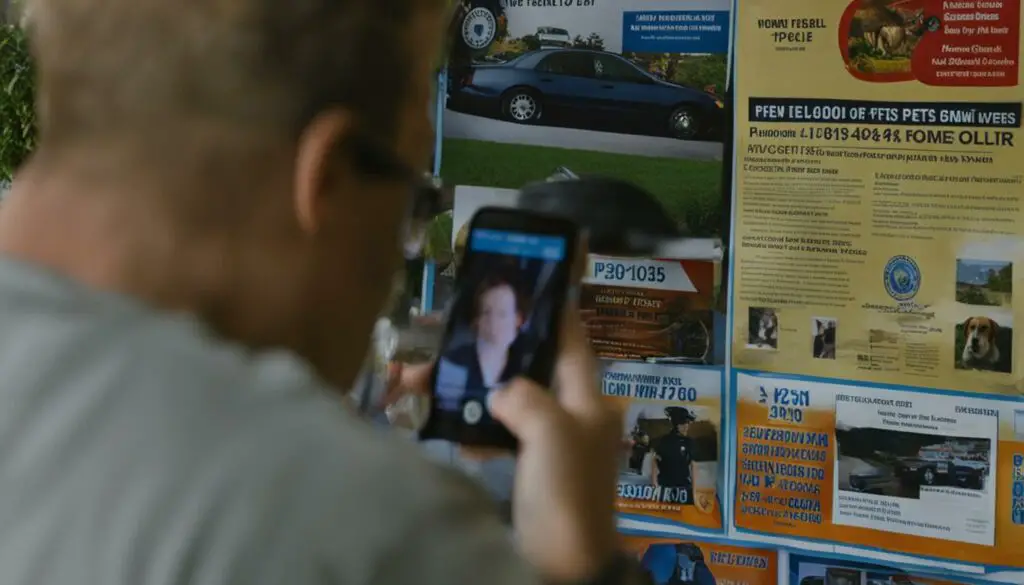Losing a beloved cat can be a heartbreaking experience for any cat owner. Knowing when to stop searching for a lost cat can be a difficult decision to make. In this article, I will provide essential tips and guidance to help you determine when it’s time to stop looking for your missing feline friend.
Key Takeaways:
- It’s important to remain hopeful and persevere in your efforts to find your lost cat.
- Statistics show that 61% of lost cats are recovered within a year.
- Conduct a thorough physical search within approximately 545 yards from where your cat went missing.
- Remember that 59% of lost cats return home on their own.
- Utilize online resources, such as pet databases and social media, to spread the word.
The Statistics of Finding a Lost Cat
When a cat goes missing, it can be a distressing and worrisome time for any cat owner. However, understanding the statistics of finding a lost cat can provide hope and guidance during the search. According to research, approximately 15% of cat owners will experience a lost cat situation within a five-year period. This means that it’s not uncommon for cats to go missing, and you’re not alone in this situation.
The good news is that the majority of lost cats are eventually reunited with their owners. Statistically, 61% of lost cats are recovered within a year. Additionally, one-third of lost cats are found within the first week of going missing. These figures highlight the importance of not giving up too quickly when searching for a lost cat.
While the statistics are promising, every cat and situation is unique. Some cats may require more time and effort to be found, while others may return home on their own. It’s essential to remain patient, proactive, and persistent in your search for your missing feline companion.

Remember, these statistics are meant to provide general insights and should not discourage you from doing everything you can to find your lost cat. There are various strategies and resources available, which will be discussed in the following sections, to help increase the chances of locating your beloved pet. By remaining hopeful and persevering in your search, there is a good chance of being reunited with your lost cat.
Physical Search: Increasing the Chances of Finding Your Lost Cat
Losing a cat is a distressing experience, but the good news is that there are proactive steps you can take to increase the likelihood of finding your missing feline friend. One of the most effective methods is conducting a thorough physical search of the surrounding area. By following these steps, you can maximize your chances of locating your lost cat.
Checking Your Home’s Yard
Start your search by thoroughly inspecting your home’s yard. Cats are often skilled at finding hiding spots in familiar environments. Look under decks, in bushes and trees, and in any other areas where your cat may be seeking refuge. Remember to call out for your cat and listen for any signs of movement or distress.
Walking and Driving Around the Neighborhood
Expand your search beyond your property by walking and driving around your neighborhood. Cats are known to roam relatively short distances when they go missing, so it’s essential to cover a wide area. Keep an eye out for any sightings or signs of your cat, such as food bowls being emptied or paw prints on cars or fences.
Seeking Permission from Neighbors
Don’t hesitate to reach out to your neighbors and ask for their assistance. They may have spotted your cat or have information that can help narrow down the search. Be sure to provide them with a clear description and a recent photo of your cat so they can easily identify them.
| Physical Search Checklist | Completed |
|---|---|
| Checked my home’s yard thoroughly | Yes/No |
| Walked and drove around the neighborhood | Yes/No |
| Sought permission from neighbors | Yes/No |
Remember, conducting a physical search is just one aspect of finding a lost cat. It’s important to combine this strategy with other methods, such as checking animal shelters, utilizing online resources, and engaging with local communities. Stay positive and persistent in your search, and keep the hope alive that you will be reunited with your beloved cat.

Lost Cats Returning Home On Their Own
While conducting a physical search is crucial, it’s important to remember that cats often have a remarkable ability to find their way back home. This innate sense of direction is still not fully understood by scientists, but it plays a significant role in the return of lost cats to their owners. Cats rely on their keen senses, such as their acute sense of smell and hearing, to navigate their surroundings and navigate back to familiar territory.
Many lost cats have been reported to return home after weeks or even months of being missing. They may retrace their steps or follow scent trails to find their way back. It’s believed that cats can use landmarks, familiar scents, and visual cues to guide them on their journey home. Their strong attachment to their territory and their desire to return to the comfort and safety of their familiar environment also contribute to their determination to find their way back.
However, it’s important to note that not all lost cats will be able to return home on their own. Factors such as the distance traveled, the presence of physical barriers, and the cat’s individual circumstances can affect their ability to find their way back. That’s why it’s crucial to continue actively searching for your lost cat and utilize other resources to increase the chances of a successful reunion.
Table: Factors Affecting a Lost Cat’s Ability to Return Home
| Factors | Description |
|---|---|
| Distance traveled | The farther a cat has wandered, the more challenging it becomes for them to find their way back due to unfamiliar surroundings and potential physical barriers. |
| Physical barriers | Natural or man-made obstacles such as highways, rivers, or densely populated urban areas can hinder a cat’s ability to navigate back to their home. |
| Individual circumstances | Factors such as age, health, and familiarity with the area can impact a cat’s ability to find their way back home. Older or ill cats may have reduced sensory abilities, making it more difficult for them to navigate. |
While it’s heartening to know that many lost cats do find their way back home, it’s essential to actively search for your missing cat and utilize various resources such as physical searches, online platforms, and community engagement. By combining these efforts, you can increase the likelihood of a successful reunion with your beloved feline companion.

Indoor Cats vs. Outdoor Cats
When it comes to lost cats, understanding the differences between indoor cats and outdoor cats can provide valuable insights when searching for your feline friend. Research shows that there are distinct variations in the likelihood of finding a lost indoor cat compared to a lost outdoor cat.
According to statistics, 75% of lost indoor cats are eventually reunited with their owners. This higher percentage can be attributed to the fact that indoor cats tend to stay closer to home and have limited exposure to unfamiliar territories. Their familiarity with the surroundings and their instinct to seek shelter and safety often result in a swifter return home.
On the other hand, the chances of finding a lost outdoor cat are lower, with only 33% being successfully recovered. Outdoor cats have a wider range of exploration and are more likely to venture into unfamiliar areas, increasing the difficulty of locating them. Their natural curiosity and territorial instincts can lead them to roam further, making a prolonged search necessary.
| Lost Indoor Cats | Lost Outdoor Cats | |
|---|---|---|
| Percentage Reunited | 75% | 33% |
| Search Range | Closer to home | Wider and further |
| Behavior | Seek shelter and safety | Curious and territorial |
While these statistics provide general insights, it’s important to remember that every lost cat situation is unique. Factors such as the individual cat’s personality, previous outdoor experience, and the specific circumstances of their disappearance can influence the outcome. Regardless of whether your cat is an indoor or outdoor cat, remaining persistent, utilizing various search strategies, and seeking support from your community can significantly increase the chances of finding your beloved pet.

With this understanding, let’s explore further strategies and resources to aid in your search for a lost cat.
Checking Animal Shelters
When searching for a lost cat, one important step is to check local animal shelters. These shelters often serve as temporary homes for stray and lost animals, making them a potential source of information about your missing cat. It is crucial to contact shelters in your area and provide them with a detailed description and any identifying features of your cat.
If your cat is microchipped, make sure to inform the shelter staff. They can scan for the microchip and contact you immediately if your cat is found. However, it is important to note that not all cats have identification tags or registered microchips, so regular follow-up visits to the shelter are necessary.
Remember, animal shelters may have a large number of cats coming in and out, so it’s important to be proactive and regularly check with them. You can provide them with updated information and inquire about any new cats that match the description of your lost cat. By staying in touch with animal shelters, you increase the chances of being reunited with your beloved feline friend.

Utilizing Online Resources
When searching for a lost cat, online resources can be incredibly valuable in maximizing your chances of finding your furry friend. There are several platforms and databases available that can help spread the word and connect with individuals who may have seen or found your lost cat.
Lost and Found Pet Databases
One way to utilize online resources is by registering your lost cat on dedicated lost and found pet databases. Websites like Pet FBI offer a centralized database where you can post a lost cat report and receive email alerts for matching reports. This allows for a wider reach and increases the chances of someone recognizing your cat and providing information on their whereabouts.
Online Classifieds and Social Media
Platforms like Craigslist and social media can also serve as powerful tools in your search for a lost cat. You can create posts with pictures and detailed descriptions of your missing cat, reaching a vast audience within your local community and beyond. Identify local community groups or pet lover pages on social media platforms, and share your story there to increase visibility and engagement.
Collaborating with Online Communities
Besides utilizing databases and online platforms, it’s beneficial to actively engage with online communities dedicated to lost and found pets. These communities provide a supportive network of individuals who understand the emotional turmoil associated with a missing pet and can offer guidance, advice, and moral support.
By leveraging online resources and engaging with relevant platforms, databases, and communities, you can increase the chances of finding your lost cat. Remember to regularly update your posts and remain active in your search, as new leads or sightings may arise. Stay optimistic and persistent, as many lost cats have been successfully reunited with their owners through the power of online networks.
The Importance of Posters and Flyers
When searching for a lost cat, utilizing physical posters and flyers in your local community can significantly increase the chances of finding your beloved feline friend. Creating eye-catching posters and flyers is an effective way to generate awareness and gather potential leads. Posters for lost cat should include a clear picture and description of your missing cat, along with your contact information.
Place these posters in visible locations such as utility poles, community bulletin boards, and local businesses. By doing so, you engage the community and enlist their support in your search. Flyers for missing cat act as a visual reminder to everyone who sees them, increasing the likelihood that someone will recognize and report sightings of your lost cat.
Remember to include keywords such as “Lost Cat” and “Reward” on your posters and flyers to attract attention. Additionally, consider offering a small monetary reward to incentivize people to actively search and provide any information they may have.
| Benefits of Posters and Flyers | Tips for Effective Posters and Flyers |
|---|---|
|
|
Remember to regularly check and replace your posters and flyers as they may become weathered or taken down. This ongoing effort will help to ensure that your missing cat remains in the minds of the community. With the support of your local community, your search for your lost cat can be more effective and increase the chances of a happy reunion.

Engaging Online Communities and Lost & Found Pages
When searching for a lost cat, engaging with online communities and utilizing dedicated lost and found pet pages on platforms like Facebook can be incredibly helpful. These online resources provide a platform for sharing your story, posting pictures, and providing detailed information about your missing cat. By actively participating in these communities, you increase the chances of someone coming across your lost cat.
Online communities for lost cats offer a supportive network of individuals who understand the pain and worry of losing a beloved pet. These communities can provide emotional support, advice, and guidance during this difficult time. Sharing your experience with others who have gone through similar situations can bring a sense of comfort and understanding.
Additionally, posting in lost and found pet pages on social media platforms such as Facebook can help spread the word about your missing cat to a wider audience. These pages are dedicated to connecting lost pets with their owners and can reach a large number of people in your local community. By sharing your post and asking others to share it as well, you increase the visibility of your search and the likelihood of finding your lost cat.
| Online Communities and Pages | Benefits |
|---|---|
| Facebook Lost and Found Pet Pages | Wide reach within local community |
| Online forums and message boards | Opportunity to connect with experienced individuals |
| Instagram hashtags | Increased visibility for your lost cat |
Remember to provide as much information as possible when posting in these online communities and pages. Include clear pictures of your lost cat, a description of their appearance, any distinctive markings, and the location and date they went missing. Be responsive to any comments or messages you receive, as someone may have helpful information or a potential sighting to share.
Engaging with online communities and lost and found pet pages can significantly increase your chances of finding your lost cat. By harnessing the power of social media and connecting with individuals who care, you create a network of support that can help bring your missing feline friend back home.
Contacting Local Authorities and Services
When searching for a lost cat, it’s crucial to reach out to local authorities and services for assistance. Contacting animal control and the police can be beneficial, as they may receive reports of stray or found cats in the area. Providing them with information about your missing cat can increase the chances of a successful reunion.
It’s also important to notify microchip companies about your lost cat. If your feline friend is microchipped, the company can update their records and contact you if your cat is found and scanned. This can be a valuable tool in reuniting with your cat.
Additionally, contacting local vet clinics is recommended. Sometimes, Good Samaritans bring lost or injured cats to these clinics for medical treatment. By informing them about your missing cat, you increase the likelihood of being reunited.

Table: Local Authorities and Services Contact Information
| Authority/Service | Contact Information |
|---|---|
| Animal Control | Phone: [phone number] Email: [email address] |
| Police Department | Phone: [phone number] Email: [email address] |
| Microchip Company | Phone: [phone number] Email: [email address] |
| Local Vet Clinics | Phone: [phone number] Email: [email address] |
By taking the necessary steps to contact local authorities and services, you can maximize your chances of finding your lost cat and being reunited. Remember to provide clear and accurate information, and follow up regularly to stay updated on any potential leads.
Preventing the Loss of a Cat
As a responsible cat owner, there are several preventative measures you can take to reduce the risk of your furry companion going missing.
Spaying/Neutering
One of the most effective ways to prevent your cat from getting lost is by having them spayed or neutered. This not only helps control the cat population but also reduces their urge to roam in search of a mate. Spaying or neutering your cat can significantly decrease their desire to wander and explore beyond the safety of your home.
Outdoor Enclosures
Providing your indoor cat with an outdoor enclosure can give them the opportunity to enjoy the outdoors while minimizing the risk of getting lost. These enclosures, also known as catios, are secure spaces that allow your cat to experience fresh air, sunshine, and nature, all while staying within the confines of your property. It provides a safe and controlled environment for your cat to explore and play, reducing the chances of them venturing too far from home.
Proper Care and Supervision
Ensuring that your cat receives proper care and supervision is essential in preventing them from going missing. Regular veterinary check-ups, vaccinations, and parasite control can help keep your cat healthy and less likely to wander off. Additionally, providing a stimulating and enriching environment within your home can help satisfy their curiosity and prevent them from seeking adventure outside.
Identification
Having proper identification for your cat is crucial in ensuring they can be safely returned to you if they do happen to get lost. Collars with identification tags that include your contact information are a great way to provide a quick and easy way for anyone who finds your cat to reach out to you. Another effective method is microchipping, which involves inserting a small chip under your cat’s skin that contains your contact details. This permanent form of identification greatly increases the chances of being reunited with your lost cat.
By implementing these preventive measures, you can significantly reduce the risk of your beloved cat going missing. Remember, a little proactive effort goes a long way in keeping your feline friend safe and sound.

Understanding Why Cats Get Lost
There are several reasons why cats may wander off and get lost. One common reason is mating behavior. Unneutered or unspayed cats may feel the urge to roam in search of a mate, leading them to explore unfamiliar territory and potentially become lost. It’s important to have your cat spayed or neutered to minimize the likelihood of them wandering off in search of a partner.
Territorial instincts can also play a role in cats getting lost. Cats are naturally territorial animals and have a strong desire to establish and defend their territory. This can drive them to venture further from home, especially if they feel threatened by other cats or animals encroaching on their territory. They may become disoriented or unable to find their way back, resulting in them getting lost.
Additionally, cats may hide while sick or pregnant. When cats are ill or expecting kittens, they may seek out secluded areas where they feel safe and protected. This can lead them to hide in hard-to-reach places like basements, crawl spaces, or dense foliage, making it difficult for them to be found. It’s important to be aware of any changes in your cat’s health or behavior and provide them with proper care to minimize the risk of them becoming lost.
| Reasons Cats Get Lost | Keywords |
|---|---|
| Mating behavior | mating behavior, cats in search of a mate |
| Territorial instincts | cat’s territorial behavior, defending territory |
| Hiding while sick or pregnant | cats hiding when sick or pregnant, seeking secluded areas |
Understanding the reasons why cats get lost can help cat owners better comprehend the behavior of their missing feline companions. By recognizing these factors, you can take necessary precautions and be vigilant in keeping your cat safe and secure.
Attracting a Lost Cat Back Home
When a beloved cat goes missing, it’s essential to take proactive steps to attract them back home. Creating a familiar environment is key to luring a lost cat back. One effective method is to leave items with familiar scents around your home. Place their bedding or some used litter in visible areas, as these scents can serve as a beacon for your cat to find their way back.
Using familiar sounds can also help attract a lost cat. Make enticing noises or use their favorite calls to beckon them home. Cats have highly developed hearing, and hearing your voice or familiar sounds can motivate them to return. Additionally, consider setting up a humane trap with food and water. This approach can safely capture your lost cat when they come to eat, providing a secure way to bring them back home.
Remember that patience is key when trying to attract a lost cat. They may be scared or disoriented, so creating a calm and welcoming environment is essential. Avoid making any sudden movements or loud noises that could frighten them away. Instead, create a peaceful and inviting atmosphere that encourages them to return home.
| Attracting a Lost Cat Back Home |
|---|
| Leave familiar scents: Place bedding or used litter in visible areas |
| Use familiar sounds: Make enticing noises or use their favorite calls |
| Set up a humane trap: Provide food and water to capture them safely |
| Create a calm environment: Avoid sudden movements or loud noises |

By following these strategies, you can increase the chances of attracting your lost cat back home. Remember to combine these techniques with other search methods, such as contacting local authorities, posting flyers, and utilizing online resources. Be patient and persistent in your efforts, as attracting a lost cat may take time. With love, care, and a familiar environment, there is hope for a joyful reunion with your beloved feline companion.
Seeking Closure and Moving Forward
After an extensive search and exhausting all possible avenues to find your lost cat, it may be necessary to find closure and accept the reality that your feline companion may never be found. This can be an emotional and challenging process, but it is important for your own well-being to begin the healing journey.
Coming to terms with the loss of a beloved pet is a personal and unique experience. Grieving is a natural response, and it is essential to give yourself permission to feel and process the emotions that accompany the loss. Seek support from friends, family, or online communities who have experienced similar situations and can offer empathy and understanding during this difficult time.
As you begin to navigate the path of healing, consider engaging in activities that promote emotional well-being. This could involve participating in hobbies that bring you joy, practicing self-care, or seeking solace in nature. Remember to be patient with yourself and allow the healing process to unfold at its own pace.

For some individuals, getting another pet may provide comfort and companionship. While no pet can replace the unique bond you had with your lost cat, opening your heart to a new furry friend can bring joy and love back into your life. It is important to take the time to mourn and heal before considering a new pet, ensuring that you are emotionally ready to provide the love and care they deserve.
Conclusion
In conclusion, searching for a lost cat can be a challenging and emotional journey for any cat owner. It’s important to remember that finding closure and moving forward is a personal process that takes time. While there may come a point when it’s necessary to stop actively searching, there is always hope that your lost cat will be found.
Throughout this difficult time, it’s essential to take care of your emotional well-being. Seek support from friends, family, and online communities who understand the unique bond between humans and animals. Remember, you are not alone in this journey.
While finding closure is important, it’s also crucial to remain hopeful and persevere in your efforts to find your missing feline friend. Many lost cats have been reunited with their owners after weeks or even months of being missing. Keep spreading the word, utilize online resources, and continue engaging with your local community.
Lastly, if appropriate for you, consider opening your heart to another pet. While no pet can replace the one you lost, a new furry companion can provide comfort and companionship as you heal. With time, you will find solace in the memories of your lost cat and the joy of welcoming a new four-legged friend into your life.
FAQ
When should I stop looking for my lost cat?
You should consider stopping your search if your lost cat has been missing for a significant amount of time, and all reasonable efforts have been made to find them.
How long do most lost cats take to be found?
Statistically, one-third of lost cats are found within seven days of going missing. However, every situation is unique, and some cats may be found after weeks or even months.
How far should I search when looking for my lost cat?
Research shows that approximately 75% of missing cats are recovered within 545 yards from where they ran away. It’s crucial to conduct a thorough search of your immediate surroundings.
Can lost cats find their way back home?
Yes, cats have an excellent sense of direction, and 59% of cat owners are reunited with their lost cats because the cats find their way back home on their own. However, active searching is still important.
What are the chances of finding a lost indoor cat compared to an outdoor cat?
Research shows that 75% of lost indoor cats are reunited with their owners, while only 33% of lost outdoor cats are found. Indoor cats have a higher likelihood of being closer to home.
Should I contact animal shelters when searching for my lost cat?
Yes, it’s crucial to contact local animal shelters and provide them with information about your lost cat. If your cat has a microchip, inform the shelter, as they can scan for the microchip and contact you if your cat is found.
Are there any online resources that can help me find my lost cat?
Yes, websites like Pet FBI offer a centralized database where you can post a lost cat report and receive email alerts for matching reports. Platforms like Craigslist and social media can also be valuable for reaching a wide audience.
How can posters and flyers help in finding a lost cat?
Creating and posting physical posters and flyers in your neighborhood can generate awareness and gather potential leads. Include a clear picture and description of your lost cat, along with your contact information.
Are there online communities I can engage with to find my lost cat?
Yes, online communities and dedicated lost and found pet pages on platforms like Facebook can be invaluable resources. Share your story, post pictures, and provide detailed information to engage with the community and increase the chances of someone coming across your lost cat.
Who else should I contact besides animal shelters when searching for my lost cat?
It’s essential to reach out to other relevant authorities and services, including animal control, the police, microchip companies, and local vet clinics. Notify them about your missing cat and provide them with your updated contact information.
What can I do to prevent my cat from getting lost in the future?
Taking preventative measures such as spaying/neutering your cat, providing an outdoor enclosure, ensuring proper care, and using identification tags or microchips can significantly reduce the risk of a cat going missing.
Why do cats get lost?
Cats may wander off and get lost for various reasons, including mating behavior, territorial instincts, and the need to establish and defend their territory. Cats may also hide while sick or pregnant, seeking secluded areas.
How can I attract my lost cat back home?
Leave familiar scents and items around your home, use enticing noises or familiar calls, and consider setting up a humane trap with food and water to capture your lost cat safely.
What should I do if I can’t find my lost cat and need to find closure?
It may be necessary to find closure and accept that your lost cat may never be found. This process involves grieving and slowly moving forward. Taking care of your emotional well-being and seeking support from friends, family, and online communities is important.








